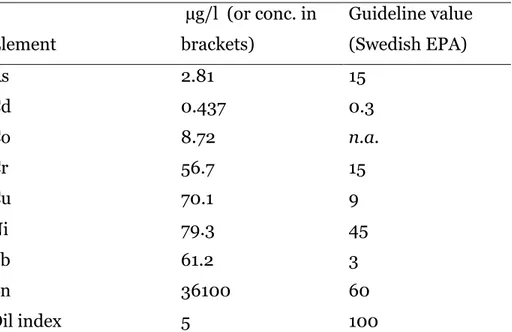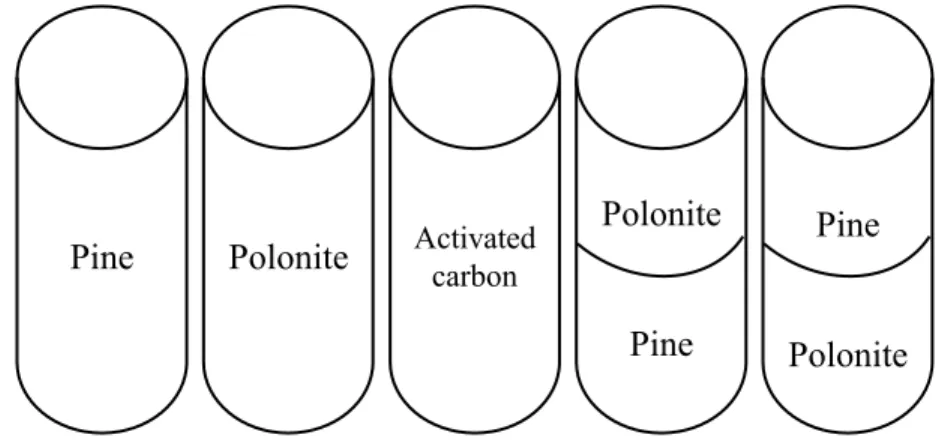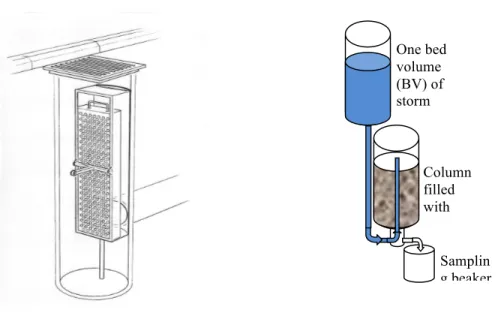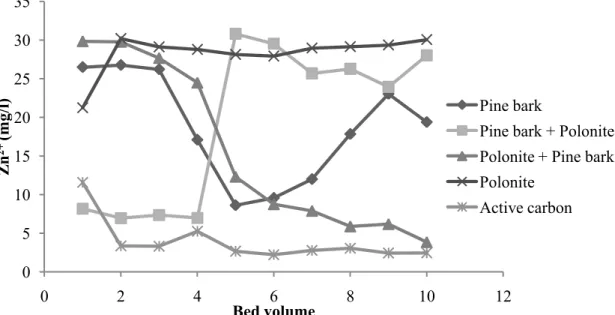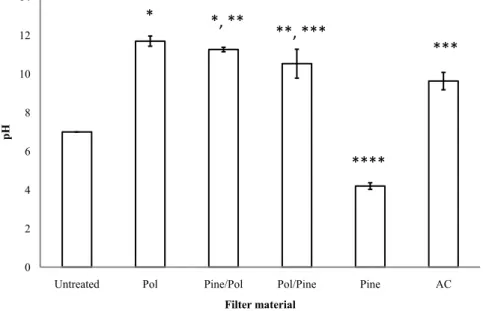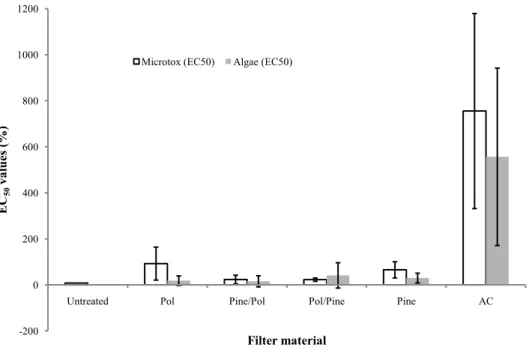COMPARATIVE STUDY OF FIVE FILTER TYPES FOR STORMWATER TREATMENT: USING A WHOLE EFFLUENT ASSESSMENT APPROACH TO EVALUATE FILTER PERFORMANCE
V. RIBÉ*, E. NEHRENHEIM*, P. CARLSSON**, P. ENEROTH***, M. ODLARE*, R. BERGLIND****
*School of Sustainable Development of Society and Technology, Mälardalen University, SE-72123 Västerås, Sweden
**Structor Environmental Technology, SE-632 20 Eskilstuna, Sweden ***Flexiclean, Growhouse, Isafjordsgatan 39B, SE-164 40 Kista, Sweden
**** FOI CBRN Defence and Security, Swedish Defence Research Agency, SE- 901 82 Umeå, Sweden KEYWORDS: WHOLE EFFLUENT ASSESSMENT; COLUMN FILTER; PINE BARK; POLONITE; MICROTOX; UMU
The release of hazardous substances to the environment from industrial activities in Sweden is heavily restricted due to pieces of legislation such as the Industrial Emissions Directive (2010/75/EU). In the directive, the whole effluent assessment (WEA) methodology is included as a suitable approach to characterization of effluent waters. The use of WEA methods in the evaluation of treatments for complex effluent waters has great advantages when comparing to using chemical analysis of individual substances alone. In this comparative study the WEA methodology of combining toxicity testing with chemical analysis was applied to evaluate the performance, stability and safety of four stormwater filter types in comparison with the conventional filter material active carbon. The filter materials were the two sorbent filter materials pine bark and polonite; and the two combination filters pine bark/polonite (filtration through pine bark followed by filtration through polonite) and polonite/pine bark (filtration through polonite followed by filtration through pine bark). The stormwater treated in the study was sampled from two points at a metals manufacturing site in mid-Sweden. A preliminary analysis of the water showed high concentrations of heavy metals and in particular of Zn, with concentrations exceeding 36 mg/L. The stormwater pH was neutral (7.5) and suspended solids content was approximately 130 mg/l. Samples of the stormwater, corresponding to ten filter bed volumes, were filtered through a pilot-scale 250 ml filter columns with the four filters or activated carbon. The filtered water samples were analysed for Zn and pH. An aquatic ecotoxicity test battery was used to measure acute and chronic toxic effects of the untreated and treated stormwater samples.
The test battery assessed luminescent bacteria acute toxicity (30-min Microtox® ISO 11348-3 using Vibrio fischeri), growth inhibition of the green unicellular algae Pseudokirchneriella subcapitata and genotoxicity with the bacterial umu assay using Salmonella typhimurium TA1535/pSK1002 (ISO 13829). The pine bark sorbent showed the highest average Zn removal efficiency of the single filter materials after activated carbon. The results from the stormwater filtration with combination materials were difficult to interpret. All filter types, except pine bark, increased pH of the treated waters > 9. Pine bark lowered the pH of the treated water below 5 even after filtration of 10 bed volumes of stormwater. Although pH of the treated waters was only adjusted for the Microtox test, there was a statistically significant positive correlation between the response of this test and the algal assay. Activated carbon showed the highest reduction of Zn contamination and toxicity of the treated waters. There was no significant correlation between the level of zinc contamination and toxic response of the treated waters. Although pine bark lowered pH significantly, in comparison to the other filter types, there was no significant correlation between the pH and the toxic response of the filtered waters.
1. INTRODUCTION
The release of hazardous substances to the environment from industrial activities in Sweden is heavily restricted due to pieces of EU legislation such as the Water Framework Directive (EC, 2000) and the Industrial Emissions Directive (2010/75/EU), IED. In the IED, the whole effluent assessment (WEA) methodology is included as a suitable approach to
characterization of effluent waters. The use of WEA methods in the evaluation of treatments for complex effluent waters has great advantages when comparing to using chemical analysis of individual substances alone. This type of assessment is based on a combination of chemical and biological (effect-based) analyses, where, in addition, a consideration of the status of the receiving waters is made. Particular attention is paid to persistent, bioaccumulating and toxic substances (OSPAR, 2007).
Apart from removing contaminants such as heavy metals and organic compounds, the filtration process may also alter physicochemical parameters such as pH, hardness (Renman et al., 2009) and dissolved organic carbon (DOC) (Ribé et al., 2009) of the treated water. Several studies have investigated the effect of the physicochemical water matrix on the
speciation, bioavailability and, hence, toxicity of metal contaminants (Di Toro et al., 2001; De Schamphelaere and Janssen, 2002; Nyogi and Wood, 2004) .
In this study, the WEA concept was used for a holistic evaluation of the filter efficiency of four stormwater filter types in comparison to activated carbon. The proposed treatment set-up was to use a sorbent filter as a passive barrier for filtering water from the storm water well pipeline. The aims of the study was to measure and compare the metal removal efficiency of the five filters and to investigate the effects of filtration and contaminant removal on the toxicity of the treated waters.
2. MATERIALS AND METHODS
2.1 Stormwater
The stormwater was sampled at two points of the industrial site. After sampling the stormwater was stored at 4ºC and prior to filtration the two samples were pooled and thoroughly mixed. A preliminary analysis of the stormwater had shown elevated levels of some heavy metals; with zinc levels exceeding the Swedish Environmental Protection Agency’s Environmental guideline values by more than 600 times, see Table 1 . A
determination of hydrocarbon oil index was performed. The hydrocarbon oil index is defined as the total amount of compounds extracted with a solvent, and which do not adsorb on Florisil and elute between n-decane (C10H24) and n-tetracontane (C40H82) when analysed by GC using an apolar column.
Table 1. Characteristics of the untreated stormwater from a previous sampling and analysis.
Element µg/l (or conc. in brackets) Guideline value (Swedish EPA) As 2.81 15 Cd 0.437 0.3 Co 8.72 n.a. Cr 56.7 15 Cu 70.1 9 Ni 79.3 45 Pb 61.2 3 Zn 36100 60 Oil index 5 100
pH 7.4 6-9
El cond. (mS/m) 105 n.a.
SS (mg L-1) 130 25-50
2.2 Filter materials
The filter types used in this study are shown in Figure 1. Three different filter materials; activated carbon, pine bark and polonite, were used as single filter materials. Combination filters with pine bark followed by polonite; and vice versa, were also assessed. The filter materials were rinsed for 30 min in one bed volume of doubly deionised water prior to filtration.
2.2.1 Pine bark
The pine bark (Pinus silvestris) used in this study originates from the timber industry and is a natural product used without any pre-treatment. Currently, the material is largely used as a sorbent for absorption of liquids, for example oil or gasoline. The bark is a commercial product supplied by Zugol AB in Falun, Sweden. According to supplier specifications, the pine bark has a particle diameter Ø of < 0.25 mm (7.5%), 0.25-5.0 mm (76.2%) and >5 mm (16.3%). The material consists of 85-90% pine bark and 10-15% cellulose. Its properties have been described in more detail by Nehrenheim et al. (2008).
2.2.2 Polonite
Polonite is a manufactured product originating from the cretaceous rock opoka. The major components of polonite are SiO2 (39.4%), CaO (42%), Al2O3 (4.3%) and Fe2O3 (2%). Polonite was selected as it is rich in silica and calcium and has been shown to adsorb phosphorous, nitrogen and heavy metals efficiently (Kietlinska and Renman, 2005).
Polonite Pine Polonite Pine Activated carbon Pine Polonite
Figure 1. The five filter types evaluated in the filter column comparison study.
2.2.3 Combination filters
The purpose of combining the filter materials pine bark (Pinus sylvestris) and polonite (a manufactured product originating from the cretaceous rock opoka), with complementing filter properties, was to counteract any side-effects of using a single material, such as pH changes of the treated water.
2.3 Filtration set-up
The proposed stormwater treatment set-up for the industrial site, shown in Figure 2a, is a filter cartridge filled with sorbent filter acting as a passive barrier for filtration of water from the stormwater well pipeline as the water flows out of the industrial area. The filtration of stormwater through the five different filter materials have been previously described by Nehrenheim et al. (2010), see Figure 2b. In brief, five 250 ml filter columns with a height of approximately 14 cm and inner diameter of 4 cm, containing either pine bark, polonite, pine bark/polonite (filtration through pine bark followed by filtration through polonite), or polonite/pine bark (filtration through polonite followed by filtration through pine bark) and activated carbon were used in the study. All columns were closed at the top with a head space of approximately 1 cm. The stormwater was added with a flow rate of 28 ml min-1 from an open column placed above the filter column. From the bottom of the column, a hose was connected which was leading the water through the column to be dispensed on top of the filter material inside the column. The stormwater was then filtered through the material in a downward direction. The filtered stormwater was collected in a sampling beaker at the bottom of the filter column.
Figure 2a and b. (a) The filter cartridge set-up planned for the filtration of stormwater on the industrial site in the study (see www.flexiclean.eu). (b) The column filtration set-up in the study (from Nehrenheim et al., 2010). The stormwater was filtered from a cylinder (one bed volume) through the filter column and collected in a sampling beaker. One bed volume (BV) of storm water Column filled with adsorbe nt Samplin g beaker
2.4 Chemical analyses
pH of the storm water samples before and after filter treatment was analyzed according to standard procedures.
Zinc concentrations in the storm water, before and after filtration through the five different filters, were determined by flame atomic absorption spectrophotometry in an AAS Vario 6 (Analytikjena) spectrophotometer, calibrated with matrix-matched standards, prepared from Spectrascan certified reference metal solution (Teknolab). The samples were prepared and analyzed according to Swedish standard (SIS, 1993). The detection limit for Zn was 1.4 µg/l.
2.5 Toxicity testing
2.5.1 Luminescent bacteria acute toxicity with V. fischeri (30-min Microtox®)
The toxicity of the untreated and treated stormwater samples to V. fischeri was assessed using the Microtox® ISO 11348-3 test, as described by Ribé et al. (2012). In brief, the frozen test samples were thawed on the day of the test in a water bath at 25°C. The samples and two controls consisting of deionised water were adjusted to a salinity of 20 ppt. Light inhibition in the sample compared to the control was measured after 30 minutes of incubation on a
dilution series (1:2) of each sample, with duplicates of every dilution step. The sample concentrations tested were; 80, 50, 33.33, 25, 16.67, 12.50, 8.33 and 6.25%.
EC50concentrations (30 min.) for each stormwater treatment alternative were determined from dose-response curves for the results. Inhibition values and EC50 (30-min) values were calculated for all test concentrations from duplicate samples using the MicrotoxOmni™ Software (Azur Environmentals, USA) in accordance with the ISO standard 11348-3. 2.5.2 Freshwater growth inhibition of unicellular green algae P. subcapitata
The toxicity of filter-treated stormwater samples to unicellular green algae was assessed using P. subcapitata. The tests were performed according to ISO protocol 8692 (ISO 2004) with modifications regarding growth medium and concentration range tested. Treated stormwater samples were incubated with an algal suspension in triplicates at sample concentrations of 12.5; 25; 50; and 90 % on 24-well plates (Nunc). Aliquots of filter-treated stormwater were diluted to the required concentrations with Z8 growth medium (including Gaffron’s
test sample volume), to reach a final volume of 1 ml in the plate wells. The plates were
incubated on a microplate shaker for 72 hours at 23 °C ± 2 °C under continuous, white light in an incubation chamber. Algal growth was measured at 605 nm every 24 hours with a ELx800 absorbance microplate reader (Biotek, USA), using deionised water as blank control. The inhibition EC50 values were calculated from three replicates according to the standard ISO 8692.
2.5.3 UmuC genotoxicity test with Salmonella typhimurium TA1535/pSK1002
The genotoxicity of the treated stormwater samples was measured in the umuC genotoxicity assay according to ISO protocol 13829 (ISO 2000), using Salmonella typhimurium
TA1535/pSK1002, as described by Gustavsson (2007). Briefly, the test bacteria were cultured in tryptone/glucose/ampicillin medium on 96-well plates (Nunc).Samples were serially diluted and all concentrations were tested in triplicates. A 50 µg/L nitroquinoline-1-oxide (4-NQO) was used as positive control and pure growth medium was used as negative control. Induction of genotoxicity, expressed as ß-galactosidase activity was measured as the
absorbance at 420 nm after two hours exposure, followed by two hours incubation. Growth was measured as the absorbance at 610 nm. The absorbance was measured with a ELx800 absorbance microplate reader (Biotek, USA). The validity of the tests was assessed according to ISO 13829. Samples were considered genotoxic when the induction ratio, IR ≥ 1.5.
2.6 Data analysis
Significant effects between the different filter types were evaluated by one-way ANOVA followed by Tukey’s HSD multiple comparison test. Correlations between physicochemical, chemical and toxicity parameters of the filtered waters were investigated in a two-way Pearson’s correlation analysis. The data analyses were performed using the software package SPSS 19 (SPSS Inc., Chicago, IL.).
3. RESULTS AND DISCUSSION 3.1 Filter performance
The results of the AAS analysis of the untreated and treated stormwater (bed volumes 1-10) are shown in Figure 3. The concentration of Zn in the untreated stormwater was 135.8 mg/l. The uptake of Zn varied for the filters over the 10 bed volumes of stormwater. However, the statistical analysis did not show any significant differences between the filter types with regards to Zn uptake. Activated carbon had the highest removal capacity throughout the filtration, with an average Zn uptake of 95% (average of BV 1, 4 and 10). Pine bark generally showed a high removal of Zn, with an average uptake of 85% (BV 1, 4 and 10). Polonite showed the overall lowest removal efficiency, the uptake was consistent at 80% (BV 1, 4 and 10). The Zn uptake in the polonite/pine bark combination filter improved markedly after BV4; while the opposite phenomenon was observed for the pine bark/polonite filter, where the filtration efficiency decreased dramatically after BV 4.
0 5 10 15 20 25 30 35 0 2 4 6 8 10 12 Zn 2+ (m g/ l) Bed volume Pine bark
Pine bark + Polonite Polonite + Pine bark Polonite
Active carbon
Figure 3. The average zinc concentration (mg/l) in the outgoing water after filtration of 10 bed volumes of stormwater through: pine bark; polonite; activated carbon; polonite + pine bark; or pine bark + polonite.
The average Zn concentrations (based on measurements from BV1, 4 and 10) in the water after treatment through the five different filter types are shown in Figure 4. Although the average Zn removal efficiency of the polonite/pine bark combination filter was similar to that of pine bark, the Zn uptake of the pine bark filter showed less variation over time. After filtration the concentration of Zn still exceeded the Swedish EPA guideline value in all the treated waters. 0 20 40 60 80 100 120 140 160
Untreated Pol Pine/Pol Pol/Pine Pine AC
Z n ( m g/L ) Filter material
Figure 4. The average (± S.D.) zinc concentration (mg/l) in the outgoing water after filtration of stormwater through: pine bark; polonite; activated carbon; polonite/pine bark; or pine bark/polonite (average Zn2+ concentration after treatment of BV1, 4 and 10).
The filtration process changed the pH in all the treated waters, see Figure 5. The pH increased after all filter treatment types, except pine bark, where the pH decreased dramatically (<5). Results from the statistical analysis showed significant differences between the filter types regarding changes of pH of the filtered water.
0 2 4 6 8 10 12 14
Untreated Pol Pine/Pol Pol/Pine Pine AC
pH Filter material * *, ** **** **, *** ***
Figure 5. The average (± S.D.) pH of the outgoing water after filtration of stormwater through: pine bark; polonite; activated carbon; polonite/pine bark; or pine bark/polonite (average pH after treatment of BV1, 4 and 10). The statistically significant differences (p < 0.05) between filter types are denoted with asterisks; there was no significant difference between treatments with the same number of asterisks. The unfiltered water was not included in the analysis of variance.
All the single-material filters removed suspended solids of the water to the same extent; from 130 mg/l to 80 mg/l.
3.2 Toxicity testing
The toxicity tests were valid according to the criteria of the standard protocols. The results of the Umu tests showed that none of the treated water samples were genotoxic. Results from the Microtox and algal tests are shown in Figure 7.
-200 0 200 400 600 800 1000 1200
Untreated Pol Pine/Pol Pol/Pine Pine AC
EC 50 valu es (% ) Filter material Microtox (EC50) Algae (EC50)
Figure 7. The average (± S.D.) toxicity of solutions (%) of the untreated and treated stormwater samples to V. Fischeri (Microtox 30-min) and P. Subcapitata (72h). Filtration of stormwater was performed with: pine bark; polonite; activated carbon; polonite/pine bark; or pine bark/polonite (average toxicity after treatment of BV1, 4 and 10).
The untreated stormwater showed a high acute toxicity in the Microtox test, with an EC50 value below 10 % solution of stormwater. The untreated sample was not tested in the algal test. The water treated in the activated carbon filter did not show any toxic response in either the Microtox or algal test. This result corresponded well with the chemical analysis, which showed a very high Zn removal of activated carbon; although the remaining Zn levels exceeded the Swedish EPA guideline value. The water filtered through pine bark showed a moderately high toxicity in the Microtox as well as the algal assay. Generally, the algal test showed a higher toxic response to the treated waters in comparison with the Microtox test. There was a relatively strong positive correlation (r = 0.67; p < 0.05) between the two toxicity test results. The pH of the water samples was neutralized in the Microtox test but not in the algal assay, which appears to indicate that pH did not noticeably contribute to the toxic effect detected by the algal test. Generally, the toxic response in the Microtox and algal tests varied greatly between the different bed volumes for each filter type. There was, however, no general trend for this pattern with regards to bed volume. The polonite/pine filter showed the consistently highest toxicity in the Microtox test.
Apart from the correlation in the responses of the two toxicity tests, there were no further significant correlations between the any of the physicochemical (pH and DOC), contaminant (Zn concentrations) or toxicity parameters. This illustrates the usefulness of WEA for building a “weight of evidence” when determining the hazard of effluent waters (Chapman, 2000; Chapman, 2007); the toxicity tests provide data which complement the chemical data. The WEA method was also shown here to be suitable for evaluation during filter treatment method development. Toxicity assays are valuable indicators in water treatment evaluation because factors other than the known contaminants may affect the treatment results. Earlier research has shown that untreated pine bark filter can release an excess of 60 mg/l DOC into deionised water during 24 hr leaching (Ribé et al., 2009). The organic matter released from pine bark would mainly consist of humic acids, simpler organic compounds such as carboxylic acids and polyphenols, which could form complexes and chelates with metal contaminants. Furthermore, by lowering the pH of the treated water, these compounds may also increase the mobility of metals. However, this study showed that although the pine bark filter lowered the pH of the treated water, it did not appear to affect the toxicity when compared to the toxic responses of the waters treated with the other filter types, with the exception of activated carbon.
4. CONCLUSIONS
In this comparative study of five stormwater filter types, pine bark sorbent showed the highest average Zn removal efficiency of the single material filters after activated carbon.
All filter types, except pine bark, increased pH of the treated waters > 9. Pine bark lowered the pH of the treated water below 5 even after filtration of 10 bed volumes of stormwater.
Although pH of the treated waters was only adjusted for the Microtox test, there was a statistically significant positive correlation between the response of this test and the algal assay.
Activated carbon showed the highest reduction of Zn contamination and toxicity of the treated waters. There was, however, no significant correlation between the level of zinc contamination
and toxic response of the treated waters. Although pine bark lowered pH significantly, in comparison to the other filter types, there was no significant correlation between the pH and the toxic response of the filtered water.
ACKNOWLEDGEMENTS
The authors would like to thank the company Zugol for providing filter materials for the study. The authors would also like to thank Dr Åke Forsberg for his assistance with the algal cultures used in the toxicity tests.
REFERENCES
Chapman, P.M., 2000, Whole effluent toxicity testing - Usefulness, level of protection, and risk assessment, Env. Toxicol. Chem. 19, 3-13
Chapman, P.M., 2007, Determining when contamination is pollution - Weight of evidence determinations for sediments and effluents, Env. Int. 33, 492-501
De Schamphelaere, K.A.C and Janssen, C.R. (2002) A biotic ligand model predicting acute copper toxicity for Daphnia magna: The effects of calcium, magnesium, sodium, potassium, and pH, Env. Sci. Tech. 36, 48-54
Di Toro, D.M.; Allen, H.E.; Bergman, H.L.; Meyer, J.S.; Paquin, P.R. and Santore, R.C., 2001, Biotic ligand model of the acute toxicity of metals. 1. Technical basis, Env. Tox. Chem. 20, 2383-2396
European Commission (EC), 2000, Water Framework Directive (2000/60/EC) Brussels, Belgium: European Union, 2000.
European Commission (EC), 2010, Industrial Emissions Directive (2010/75/EU) Brussels, Belgium: European Union, 2010.
Gustavsson, L.; Hollert, H.; Jonsson, S.; van Bavel, B. And Engwall, M., 2007, Reed beds receiving industrial sludge containing nitroaromatic compounds - Effects of outgoing water and bed material extracts in the umu-C genotoxicity assay, DR-CALUX assay and on early life stage development in Zebrafish (Danio rerio), Env. Sci. Poll. Res. 14, 202-211 International Organization for Standardization, 2004, Water quality – Freshwater algal
growth inhibition test with unicellular green algae ISO 8692.
International Organization for Standardization, 2007,Water quality - Determination of the inhibitory effect of water samples on the light emission of Vibrio fischeri (Luminescent bacteria test) - Part 3: Method using freeze-dried bacteria ISO 11348-3.
International Organization for Standardization, 2000, Water quality - Determination of the genotoxicity of water and waste water using the umu test ISO 13829.
Khokhotva, O. and Waara, S., 2010, The influence of dissolved organic carbon on sorption of heavy metals on urea-treated pine bark, J. Haz. Mater. 173, 689–696
Kietlinska, A. and Renman, G., 2005, An evaluation of reactive filter media for treating landfill leachate, Chemosphere. 61, 933-940
Kotai, J., 1972, Instructions for preparation of modified nutrient solution Z8 for algae. Norwegian Institute for Water Research, publication B-11/69, Blindern,Oslo
OSPAR, 2007, Practical Guidance Document on Whole Effluent Assessment. OSPAR Commission, London
Nehrenheim, E.; Waara, S.; Johansson Westholm, L., 2008, Metal retention to pine bark and blast furnace slag – on-site experiment for treatment of landfill leachate, Bioresour. Technol. 99, 998-1005
Nehrenheim E., 2010, Treatment of highly zinc (Zn) contaminated storm water by using a combination of pine bark (Pinus Silvestris) and Polonite (burned opoka) in comparison with active carbon
Niyogi, S. and Wood C.M. (2004) Biotic ligand model, a flexible tool for developing site-specific water quality guidelines for metals, Env. Sci. Tech. 38, 6177-6192
Renman, A.; Renman, G; Gustafsson, J.P. and Lars Hylander, L. (2009) Metal removal by bed filter materials used in domestic wastewater treatment, J. Haz. Mater. 166, 734–739
Ribé, V., Nehrenheim, E., Odlare, M., Waara, S. (2009) Leaching of contaminants from untreated pine bark in a batch study: Chemical analysis and ecotoxicological evaluation, J. Haz. Mater. 163, 1096–1100
